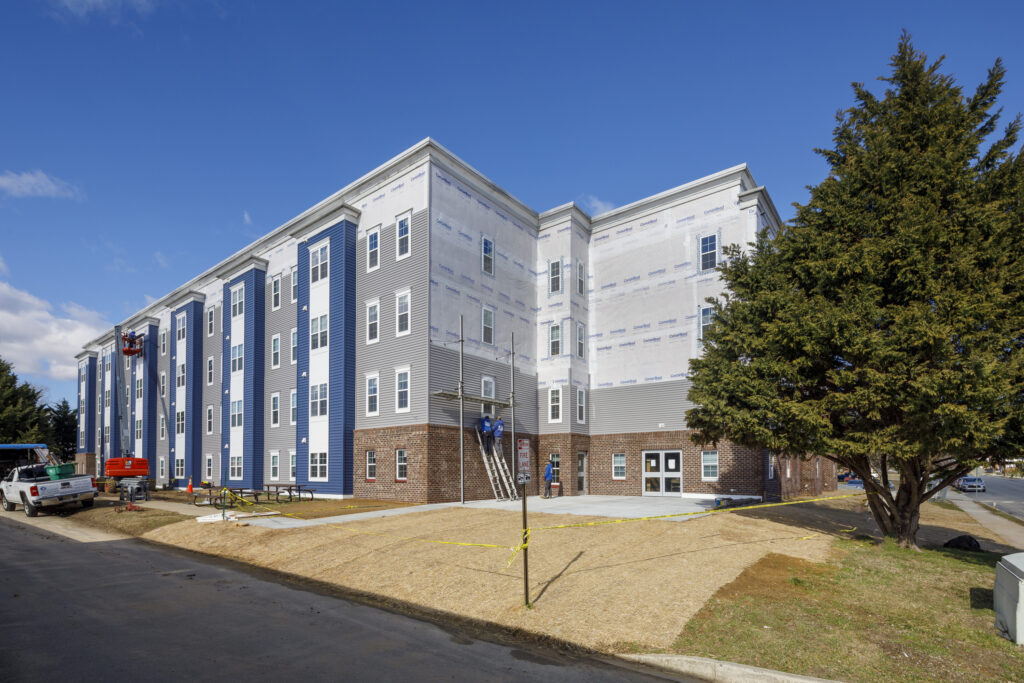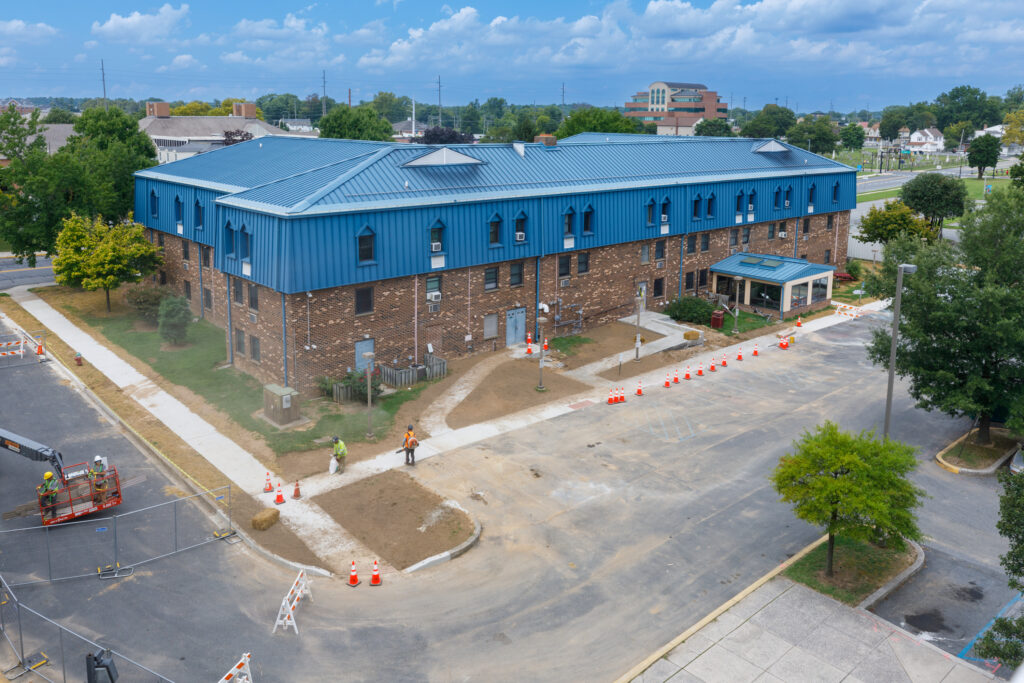Owens and Queen Manor Apartments in Dover, DE
RAD 2.0 Streamlines its Reach

By Mark Fogarty
7 min read

The Department of Housing and Urban Development’s (HUD) Rental Assistance Demonstration (RAD) program was a big idea: to raise money to rehabilitate crumbling old public housing properties by raising private equity and converting the buildings into project-based Section 8 developments. Now, a couple of modifications to RAD are increasing its reach.
The two, called the RAD/Section 18 blend and Faircloth-to-RAD, are in evidence at Queen Manor and Owens Manor, respectively. In Dover, DE, Queen Manor is an existing property that will be combined under one ownership structure with an adjacent Low Income Housing Tax Credit project called Owens Manor, which is being re-syndicated after completing its 15-year compliance period. Across both properties, all 110 units are undergoing substantial modernization.

The deal originally started to come together because Dover Housing Authority Executive Director Rufus Mincey and Executive Vice President Sean Kelly of Wilmington, DE-based developer Leon N. Weiner & Associates, Inc. (LNWA), serve together on the board of Delaware NAHRO, an affiliate of the National Association of Housing and Redevelopment Officials.
“LNWA identified that the Dover properties were prioritized under the Delaware State Housing Authority (DSHA) programs and could likely attract coveted “gap” financing. Identifying local funding opportunities was a key first accelerant,” Kelly notes.
Thomas R. Davis, director of HUD’s Office of Recapitalization, defined the two additional RAD approaches, adding that the RAD also has the capacity to support new construction.
“There are a couple of new features in this transaction that made it an interesting case study,” Davis says. “A typical RAD conversion of a public housing site involves the conversion of public housing units. The RAD rent, or more accurately the post-conversion Section 8 contract rent, is based on the public housing operating and capital subsidy for the property before the conversion, plus the tenant’s contribution to the rent.”
But the rents at many RAD deals around the country are below the fair market rent (FMR), Davis says. “That rent level has been a constraint to those conversions.”
The Queen Manor project is using a “RAD/Section 18 blend,” he says. “In the normal public housing program, a Public Housing Authority (PHA) can ask for approval to dispose of a property under what’s called Section 18 demolition and disposition authority. If HUD approves the disposition of the property, the housing authority receives tenant protection vouchers for any of the units that have been occupied in the last two years.”
In some cases, Davis says, the PHA can convert that to a Section 8 project-based contract. But “in many cases, getting approval for disposition under Section 18 proved to be a high bar. It was hard for PHAs to get the Section 18 authority to do this.”
An Innovative Blend
Davis says that in the past couple of years, HUD found an innovative way to bring the two together in a blend.
“If you were doing Section 18 and RAD together, we could make it easier to get the approval for the Section 18 disposition.
“The reason you would do this is that you might be able to get some units at the higher rent level of the tenant protection vouchers, but you’d get the more robust resident protections that come with the RAD program, and you’d get the HUD comprehensive review process for a construction rehab program. From HUD’s point of view, it also means better visibility into and oversight of the long-term future of the property.”
Bringing the two together is a win-win-win-win, Davis feels. It “has real benefits for the residents in the resident protection program, benefits for the finances of the project being able to get the blended revenue with some units at the FMR-based level, benefit for the owner in the streamlined processing, and benefit for HUD in the greater visibility and assurance that the construction work gets done.”
This would allow two different rent levels, but HUD has asked Congress to streamline it further to one blended rate.
Faircloth-to-RAD involves the legacy of a former Senator, Duncan McLauchlin “Lauch” Faircloth (R-NC), who established a limit on the number of units each PHA was allowed to have. Sean Kelly of developer LNWA points to this new program enhancement as essential to Owens and Queen Manor and something other developers can use as well.
LNWA and CSG Advisors, a municipal advisory firm with expertise in the housing sector, spotted excess “Faircloth Authority,” within the Dover Housing Authority portfolio indicating that the Faircloth Limit exceeded the total number of ACC units. Recognizing this surplus, the development team saw an opening to extend project-based rental assistance to previously unassisted Low Income Housing Tax Credit units in the Owens Manor building.
“This aspect of our transaction holds significant potential,” notes Kelly. “PHAs stand to benefit greatly from strategically leveraging their Faircloth Authority. It serves as a powerful tool to support low-income residents, facilitate greater mortgage financing and attract tax credit equity investment through the proven RAD platform.”
“Many PHAs today have units well below that maximum,” says HUD’s Davis. So, there is PHA unit authority “on the shelf.” But over the years, housing authorities have struggled to bring these units online. Barriers, including rent levels, are overcome using Faircloth-to-RAD.
“The ability to rely on a fixed contract rent, resulting from the RAD conversion, dramatically reduced the uncertainty that was associated with efforts to underwrite these projects,” Davis says. Most Faircloth-to-RAD developments have involved new construction, he says, but Owens and Queen Manor are acquisition/rehab.
There is a true blend of subsidies across the 110 units at Owens and Queen Manor. Queen Manor has 20 RAD project-based voucher (PBV) units; 30 PBV units through the Section 18 portion of the RAD/Section 18 blend; Owens Manor has 26 Faircloth-to-RAD units; and 34 non-RAD locally sourced PBV units, done through the Dover Housing Authority. The total development cost is $29.2 million.
HUD Touts Features
HUD described the following features of the deal, which commenced construction in July of 2023:
- All 110 units at both Queen and Owens Manor will be financed with four percent tax credits with no change to the properties’ occupancy type;
- A nonprofit subsidiary of the Dover Housing Authority is the managing member of the ownership entity;
- Cinnaire is the equity investor member of the ownership entity;
- LNWA is the developer, general contractor and property manager;
- There is $128,000 per unit of hard construction costs/rehabilitation;
- Rehabilitation will include the repair/replacement of the interior and exterior finishes. New thermally efficient windows will be installed with a weather-resistant barrier and proper flashing. The brick veneer will be replaced with a proper wall cavity, through-wall flashing and weeps. New equipment includes electric heat pump split systems and accessibility enhancements to the baths and kitchens in the accessible units;
- Residents will be relocated on-site during the renovation of their units; and
- CitiBank is providing $11.3 million in construction-to-permanent financing.
Kelly notes that LNWA, now entering its 75th year, was the original general contractor for Queen Manor via the turnkey Public Housing programs of the 1960s. “So, this transaction was coming full circle,” he says.
He notes the project was beneficial to residents, including “long-term affordability, major renovation and modernization across resident units, common spaces and exterior amenities.”
Queen Manor Sources and Uses
Sources
- $4,800,000 First Mortgage from CitiBank
- $11, 083,051 in LIHTC tax credit equity from Cinnaire
- $4,091,879 Seller Note/Take Back Financing
- $1,000,000 HOME funds
- $6,500,000 from the Delaware State Housing Authority (DSHA) Development Fund
- $400,000 from the State of Delaware American Rescue Plan Act Fund
- $500,000 in deferred developer fees
- $320,000 in interim income during the construction period
- $485,142 from the pre-existing reserves at Owens Manor
USES
- $7,950,000 in acquisition (including payoff of existing mortgage)
- $14,175,786 in hard construction costs (including contingency)
- $330,000 in relocation costs
- $2,751,375 in soft costs
- $1,579,402 in construction period interest
- $593,509 in reserves
- $1,800,000 in developer fee (note that $500,000 is deferred as a source)